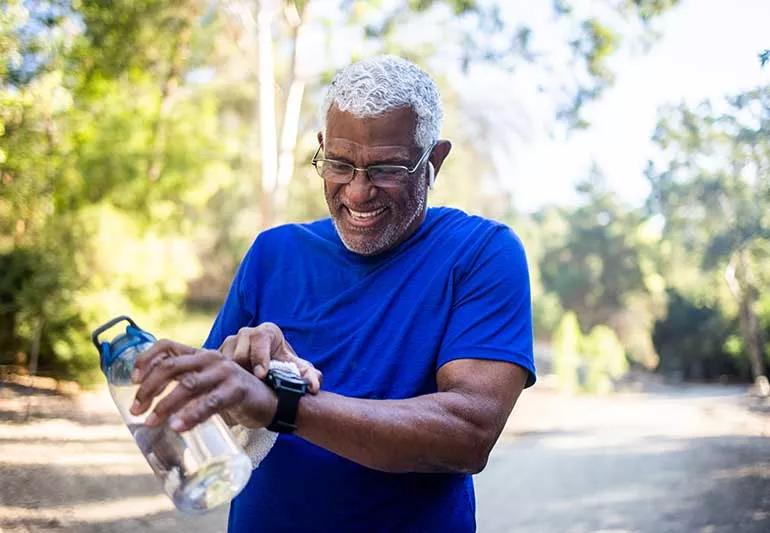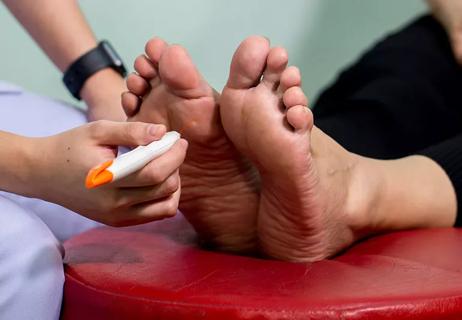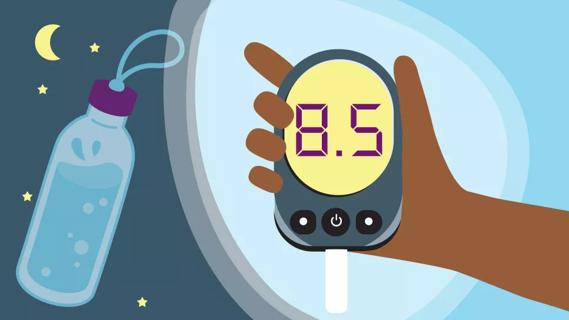Even a short walk can make a positive difference

If you have diabetes or prediabetes, odds are good that blood sugar is often on your mind. And even if you don’t have diabetes, big blood sugar swings can take you from super energized to lethargic and hangry. That’s not fun for anyone.
Advertisement
Cleveland Clinic is a non-profit academic medical center. Advertising on our site helps support our mission. We do not endorse non-Cleveland Clinic products or services. Policy
Wouldn’t it be nice if something as simple as a short walk could help keep blood sugar in line? And, in fact, research suggests walking after eating can do just that. Nurse and diabetes care and education specialist Shannon Knapp, MEd, BSN, RN, CDCES, discusses the benefits of a post-meal walk and what else to consider when managing your blood sugar levels.
Your body turns the carbohydrates you eat into sugar (glucose). When things are working well, your pancreas releases insulin. This hormone transports glucose into your cells, so your body can use it for energy. But when things aren’t working as they should, you can end up with high blood sugar.
Knapp says two things typically cause problematic hyperglycemia (high blood sugar), and insulin is at the root of both of them. You may have high blood sugar because your:
Advertisement
Why does high blood sugar matter? “Over time, elevated blood sugar causes blood vessel damage,” says Knapp. Damaged blood vessels lead to serious complications, such as:
“It’s so important to keep your blood sugar in your target range if you have diabetes,” she continues. There are many ways to nudge your blood sugar into a healthy range — including a short walk after eating.
There are many health benefits of walking, and walking after you eat can specifically benefit your blood sugar.
After meals, your blood glucose goes up (even if you don’t have diabetes). “Your blood sugar level is highest about 30 to 90 minutes after your meal,” shares Knapp. This rise is a natural response to eating, and it isn’t a concern unless your glucose spikes too high or remains at an unhealthy level.
But research shows that a short walk after eating a meal:
Any activity is helpful for your blood glucose. “Exercise impacts your blood sugar quickly, often within a few minutes,” says Knapp. “And over time, physical activity helps your body use insulin more effectively, decreasing the insulin resistance we often see in diabetes.”
The study indicates that walking just two to five minutes can bump your blood sugar down a bit. “But this isn’t a magical solution for diabetes,” states Knapp. “A post-meal walk is a great habit that benefits blood sugar, but managing diabetes never comes down to just one thing.”
Knapp also cautions that you can take exercise too far. If you’re on medication to lower your blood glucose, exercising can make it dip too low. Low blood sugar — hypoglycemia — can be dangerous.
A short walk is unlikely to cause hypoglycemia, but a hard workout could. “Always know your blood glucose levels,” Knapp advises. Timing your exercise is key. Whenever you exercise, check your glucose levels before and after activity. A blood glucose reading of less than 70 mg/dL (milligrams per deciliter) typically is in the hypoglycemic range. But before and during exercise, aiming for a blood glucose level closer to 100 mg/dL may be a safer option.
If you have a low reading, consume some fast-acting carbs to raise your glucose level. For example, drink a small cup of juice, take a spoonful of honey or use glucose tablets or gel. Your healthcare provider or diabetes care and education specialist can help you create a plan for treating hypoglycemia. And no matter what you choose to use for treating hypoglycemia, be sure to have it on hand during activity.
Advertisement
“If you have diabetes, healthy habits are part of keeping your blood glucose in your target range. This is true even if you’re taking medication to manage your blood sugar,” says Knapp.
Good habits for natural blood sugar management include:
If you have diabetes, the other vital part of blood glucose management is knowing your levels. That’s why frequent blood sugar checks are so important.
Your target blood glucose range depends on when you last ate. For adults with diabetes, typical target blood glucose levels are:
Walking after meals can help stabilize your blood sugar and insulin, which may make it easier to hit your target range. If you don’t have diabetes, you can still benefit from post-meal strolls that reduce your blood sugar spikes.
Advertisement
Learn more about our editorial process.
Advertisement

Here's what to know about this way to classify carb-containing foods

Some studies find benefits for people with diabetes

How to avoid tingling, burning or stabbing in your feet

Planning ahead, checking in with your care team and being vigilant about blood sugar monitoring can help ensure a safe fast

Keeping blood glucose levels in a healthy range is critical with diabetes-related vision issues

It can help improve heart health, reduce stress, fight food cravings and boost self-esteem

Watch your diet, exercise regularly and get a blood glucose level screening early

Regular testing can help detect diabetes early on

Type 2 diabetes isn’t inevitable with these dietary changes

Applying a hot or cold compress can help with pain